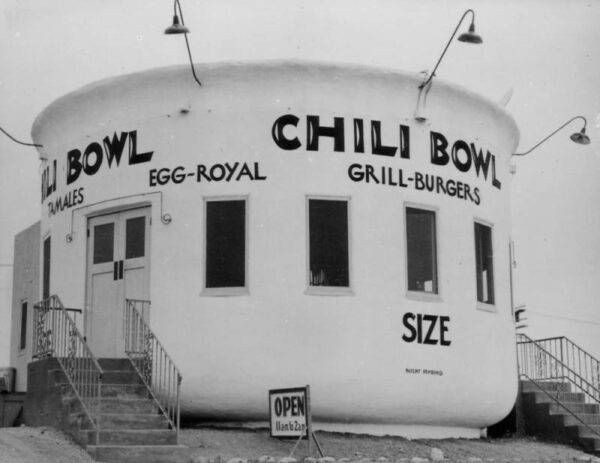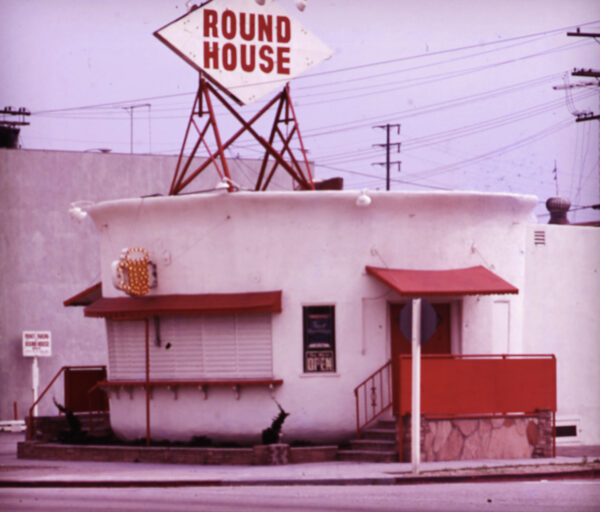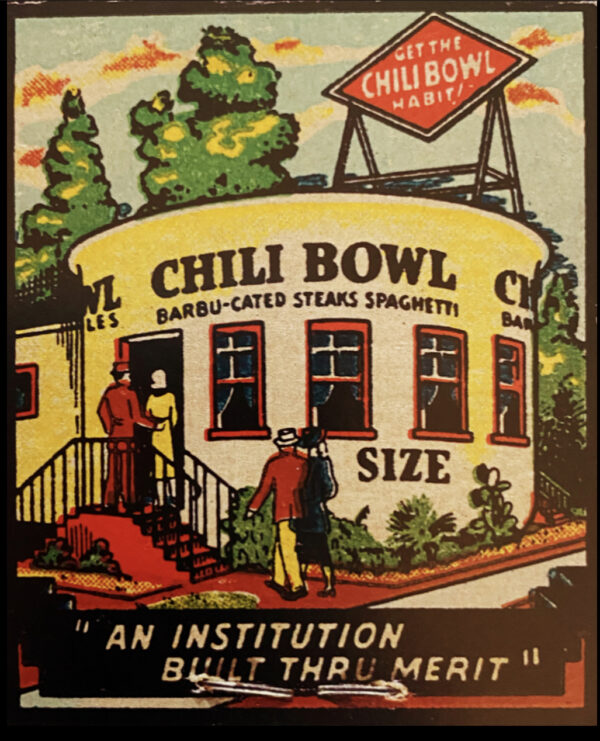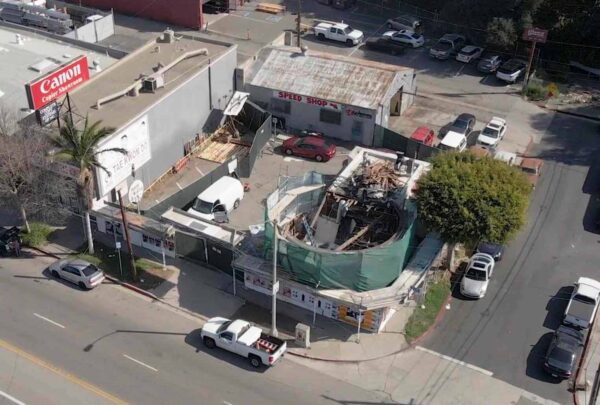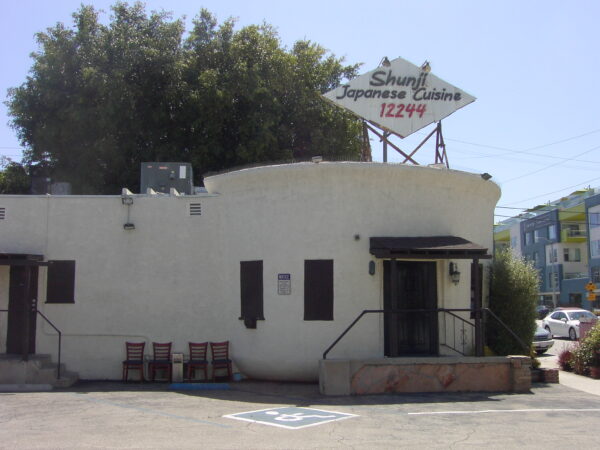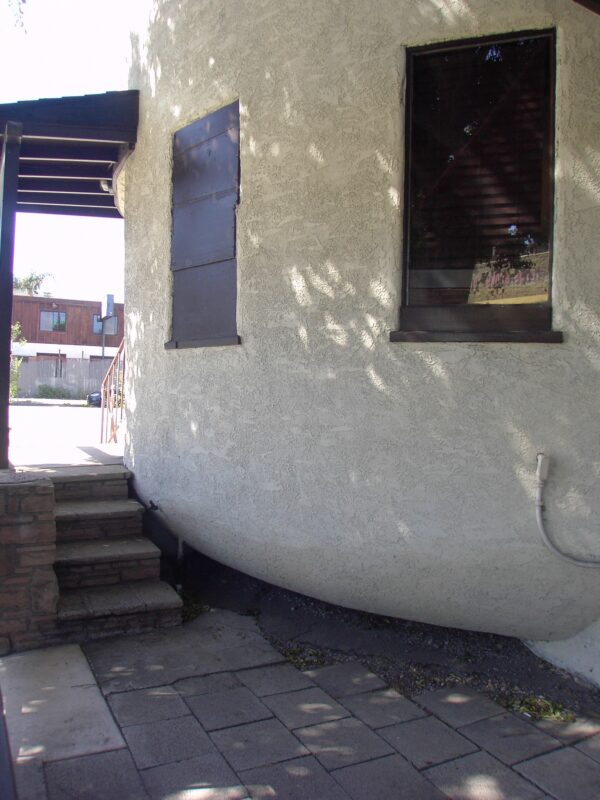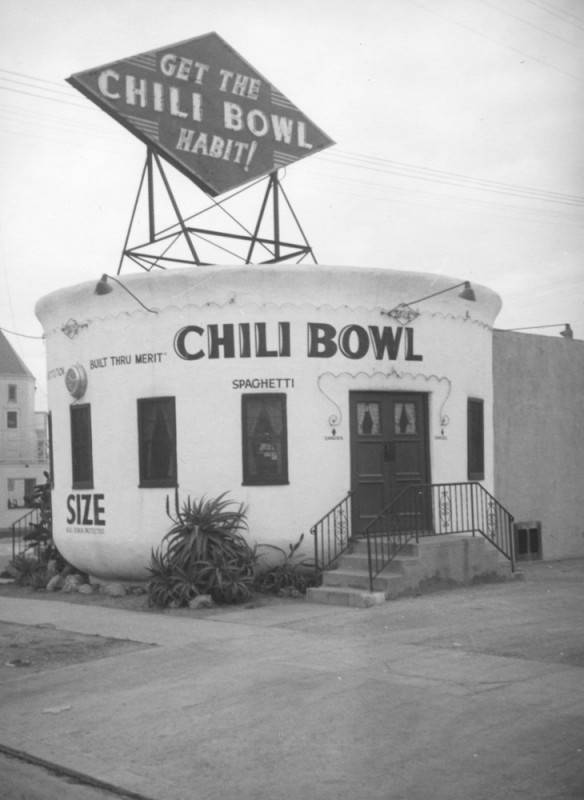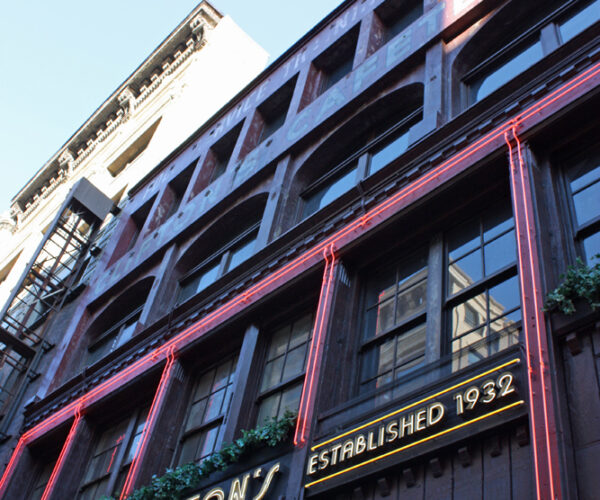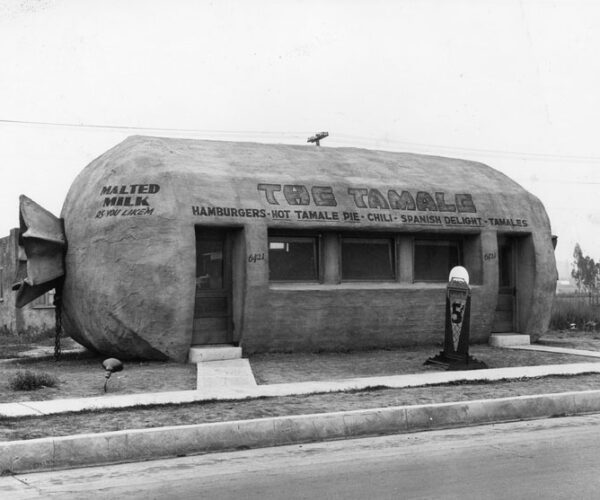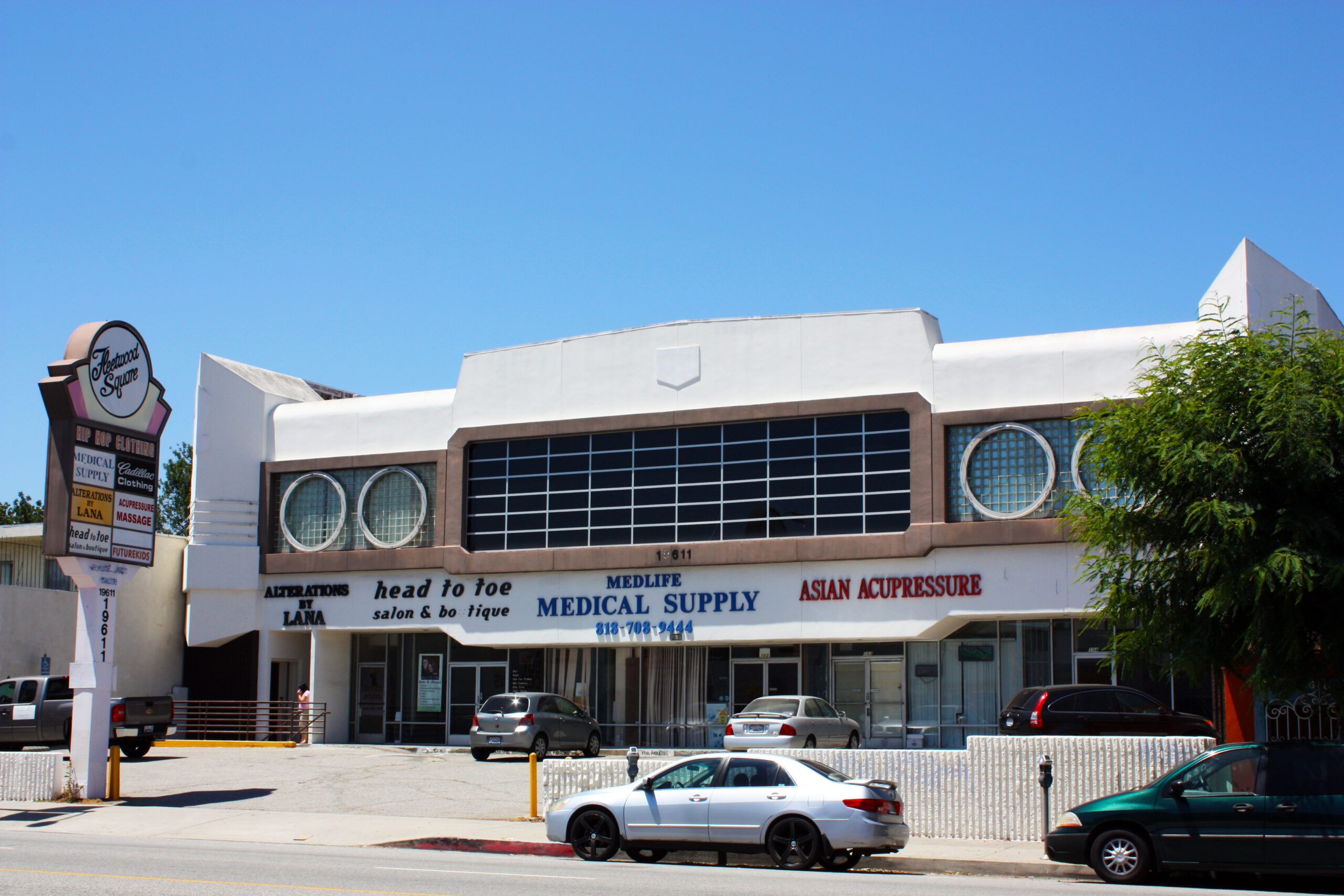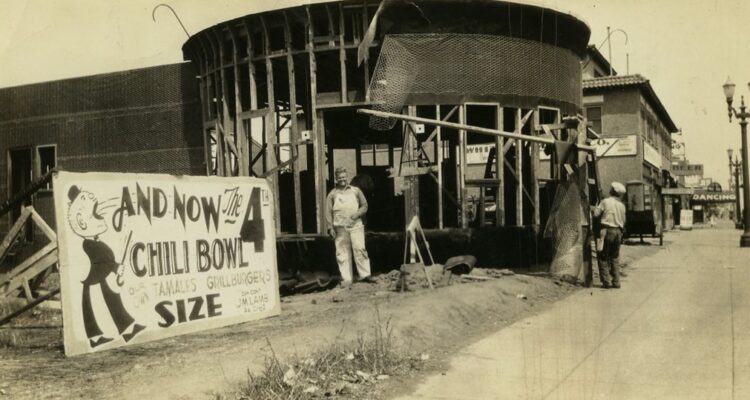
Place
Chili Bowl, West Los Angeles (Demolished)
The former 1930s Chili Bowl in West Los Angeles represented a rare example of Programmatic architecture.
Lost
In February 2022, the owner demolished the Chili Bowl, cutting it up into pieces, destroying this rare West L.A. landmark.
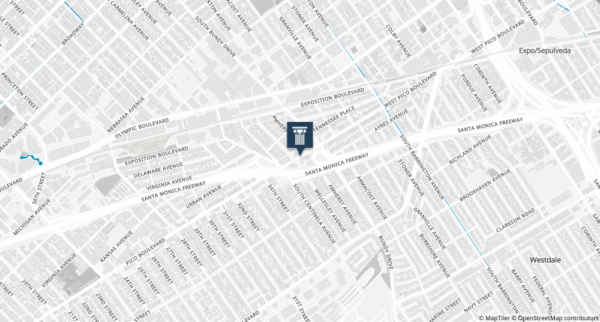
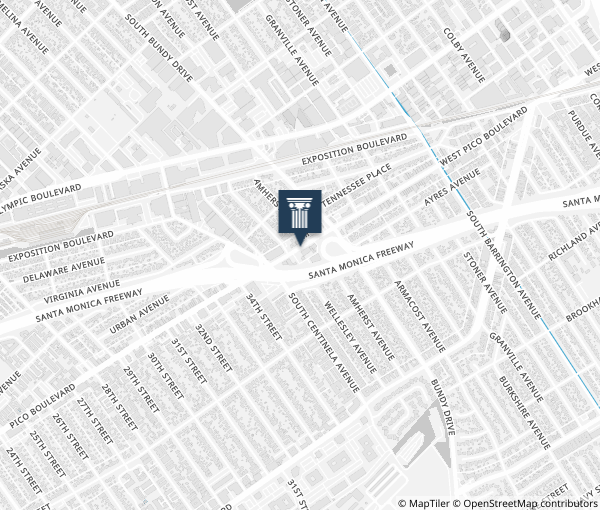
Place Details
Address
Get directions
Year
Style
Designation
Property Type
Government Officials
Community
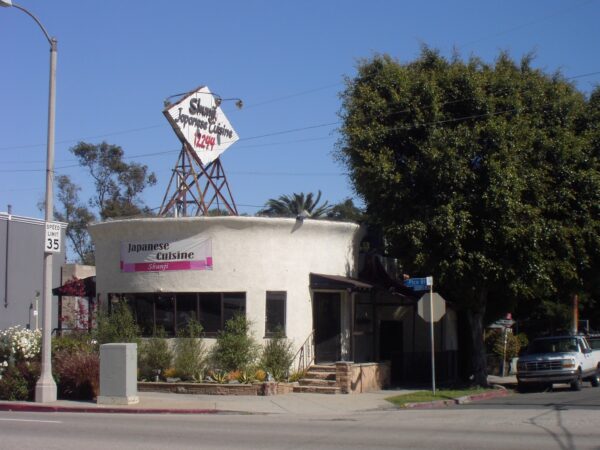
Former Chili Bowl restaurant at 12244 Pico Blvd | Photo by Marcello Vavala / L.A. Conservancy
Overview
Despite the Conservancy’s and many others’ best efforts to intervene by having L.A.’s last Chili Bowl designated as a Historic-Cultural Monument (HCM), and find a way to preserve it on-site or through relocation, the property owner began dismantling the Chili Bowl on February 16, 2022. Former Councilmember Mike Bonin’s office said the building would be stored, yet no details were provided on how or if this was done, what was being kept, where it was stored, and for how long.
On December 7, 2021, by a 3/1 vote, the City Council’s Planning and Land Use Management Committee voted to recommend denial of the Conservancy’s Historic-Cultural Monument (HCM) application for the Chili Bowl. This action was prompted by Councilmember Mike Bonin’s refusal to change his position in opposition to the Chili Bowl’s preservation. Previous to this vote, PLUM rescinded its previous recommendation and vote made on June 15, 2021, in violation of the California Brown Act.
About This Place
About This Place
The Chili Bowl is one of the last and most intact examples of the Chili Bowl franchise. The building at 12244 West Pico Boulevard is one of five remaining (18 total originally) former Chili Bowl structures from entrepreneur Arthur Whizin’s Chili Bowl restaurant chain, which numbered eighteen locations throughout Los Angeles County at its height in 1941 and 1942. Of the surviving Chili Bowls, the West Los Angeles location is the most intact and has operated nearly continuously as an eatery. The current tenant, Shunji Japanese restaurant, has operated out of the former Chili Bowl since 2012.
Constructed in 1935 as the seventh Chili Bowl restaurant chain location. Arthur Whizin, the owner of the Chili Bowl chain, relocated the building from its original location on Fletcher Drive in Silver Lake to its present site in 1939/40. Designed in the shape of a giant chili bowl, the structure is an excellent example of programmatic architecture. Buildings in this style mimic either the products sold within or the businesses’ identity.
In 1931, at the age of twenty-five, Whizin opened his first Chili Bowl restaurant at 3012 Crenshaw Boulevard. Within a decade, Whizin opened eighteen locations using his Chili Bowl design for each of his locations. To grow his business, Whizin promoted his eatery by sponsoring a baseball team, raffling rides on the Chili Bowl airplane, and advertised on a speedboat that crossed the Catalina Channel with showgirls aboard. During WWII, Whizin downsized his business chain. By 1947, all the Chili Bowl restaurants in the chain were permanently closed.
The Chili Bowl is an example of programmatic architecture, in which the building is fashioned in the shape of a business’s product or identity. Coinciding with the rise of automobile use, programmatic architecture or mimetic architecture was popularized during the 1920s along roadsides throughout the United States. During this period, the Los Angeles area was home to one of the highest concentrations of this architecture style.
Some of the Los Angeles’s most notable programmatic buildings included Van De Kamp’s Dutch Bakeries, the Big Cone ice cream stands, and the Chili Bowl restaurants. Because so few examples remain today, Programmatic architecture is considered a rare resource type. The Chili Bowl in West Los Angeles is one of the oldest surviving examples of the style in L.A.
SurveyLA identified the Chili Bowl as eligible for landmark designation at the national, state, and local levels in Los Angeles’s citywide survey, SurveyLA. The Chili Bowl in West Los Angeles is one of the oldest surviving examples of Programmatic architecture in L.A. Because so few examples remain today, Programmatic buildings are considered a rare resource type.
Our Position
In 2019 the Conservancy submitted a Historic-Cultural Monument (HCM) nomination for West L.A.’s Chili Bowl in an attempt to save it from demolition and planned redevelopment of the site.
On December 7, 2021, by a 3/1 vote, the City Council’s Planning and Land Use Management Committee voted to recommend denial of the Conservancy’s Historic-Cultural Monument (HCM) application for the Chili Bowl. This action was prompted by Councilmember Mike Bonin’s refusal to change his position in opposition to the Chili Bowl’s preservation. Previous to this vote, PLUM rescinded its previous recommendation and vote made on June 15, 2021, in violation of the California Brown Act.
Below is Conservancy testimony at the Planning and Land Use Management (PLUM) Committee:
Thank you for the opportunity to speak today regarding the 1935 Chili Bowl Historic-Cultural Monument application. The reason we are here today and why we filed the legal petition against the city for a Brown Act violation was to ensure our voice and our nearly 5,000 members, and those of the many supporters of this historic place and others can be heard, understood, and considered before voting to either support or reject this and other HCM nominations.
The stakes are high, as the Chili Bowl will most likely be lost if not afforded HCM protection and a design review process to incorporate this historic place with new housing development, or potential relocation to a safe, new receiving site. However, this type of thoughtful consideration and problem solving simply will not happen without the benefit of HCM status.
The Conservancy greatly thanks you for dialing back your previous actions, rescinding your prior vote, and approaching this with fresh new eyes and consideration.
What is before you today is the merit of whether or not the 1935 Chili Bowl is afforded historic protection through HCM status, nothing more or less. The City’s Cultural Heritage Commission and its SurveyLA program has already settled this as indeed being historic and significant as a rare, surviving example of programmatic architecture. The hard truth is there aren’t many places like the Chili Bowl left standing today in LA and elsewhere. As a thoroughly LA invention, it was designed in the 1930s as a hybrid form of business advertising and bold architecture, to attract attention from passing motorists and to put a smile on your face. It still does this today.
Only 6.2% of all of L.A. has been identified as historic, leaving nearly 94% available for new development. Because historic places here are a finite and limited resource – including the Chili Bowl — it is the reason why the Conservancy presses so hard for protections and potential ‘win-win’ outcomes when readily viable and achievable. We don’t go to bat for every old building. And we do this not to stand in the way of development or much-needed housing. Both new housing development and preservation are possible here, but only if we provide a path forward, a design review process afforded through HCM designation to compel this owner to do something other than the status quo.
We ask, isn’t LA deserving of this?
It is always going to be easier to clear a site and demolish, but that does not make it right or better for LA, our environment, and our quality of living in LA if we routinely throw away what makes us special. We think LA is most deserving of doing something better here, of giving back and celebrating our unique story, while literally adding to it, in this case with new housing and reusing a very small historic building. The Chili Bowl is unique, special and important to the story of Los Angeles, not as a grand icon, but as an everyday person’s historic place, accessible and available for a meal and a unique experience. Small in stature but with a mighty and whimsical architectural punch, the Chili Bowl can be easily incorporated as part of any new housing on this site. It requires the will, the way is already evident.
Your action today, and of Councilmember Bonin’s, will ultimately determine whether or not the Chili Bowl survives. You hold the power to decide if we go with the status quo and destroy another part of what makes LA, well LA…OR…we choose to do something special, for future residents of this site and all of Angelinos. Thank you, as we greatly appreciate the work that you do and your consideration of our request.
The Conservancy greatly thanks you for dialing back your previous actions, rescinding your prior vote, and approaching this with fresh new eyes and consideration.
What is before you today is the merit of whether or not the 1935 Chili Bowl is afforded historic protection through HCM status, nothing more or less. The City’s Cultural Heritage Commission and its SurveyLA program has already settled this as indeed being historic and significant as a rare, surviving example of programmatic architecture. The hard truth is there aren’t many places like the Chili Bowl left standing today in LA and elsewhere. As a thoroughly LA invention, it was designed in the 1930s as a hybrid form of business advertising and bold architecture, to attract attention from passing motorists and to put a smile on your face. It still does this today.
Only 6.2% of all of L.A. has been identified as historic, leaving nearly 94% available for new development. Because historic places here are a finite and limited resource – including the Chili Bowl — it is the reason why the Conservancy presses so hard for protections and potential ‘win-win’ outcomes when readily viable and achievable. We don’t go to bat for every old building. And we do this not to stand in the way of development or much-needed housing. Both new housing development and preservation are possible here, but only if we provide a path forward, a design review process afforded through HCM designation to compel this owner to do something other than the status quo.
We ask, isn’t LA deserving of this?
It is always going to be easier to clear a site and demolish, but that does not make it right or better for LA, our environment, and our quality of living in LA if we routinely throw away what makes us special. We think LA is most deserving of doing something better here, of giving back and celebrating our unique story, while literally adding to it, in this case with new housing and reusing a very small historic building. The Chili Bowl is unique, special and important to the story of Los Angeles, not as a grand icon, but as an everyday person’s historic place, accessible and available for a meal and a unique experience. Small in stature but with a mighty and whimsical architectural punch, the Chili Bowl can be easily incorporated as part of any new housing on this site. It requires the will, the way is already evident.
Your action today, and of Councilmember Bonin’s, will ultimately determine whether or not the Chili Bowl survives. You hold the power to decide if we go with the status quo and destroy another part of what makes LA, well LA…OR…we choose to do something special, for future residents of this site and all of Angelinos. Thank you, as we greatly appreciate the work that you do and your consideration of our request.
Previously, on June 15, PLUM voted to recommend against the Chili Bowl following Councilmember Bonin’s office speaking out against this nomination. The problem is the public was blocked from speaking at this meeting, including the Conservancy as the applicant.
The rehearing of this HCM nomination is a direct result of the Conservancy filing in August a Petition for Writ of Mandate with the Los Angeles County Superior Court against the City of Los Angeles. We challenged the City for violating the California Brown Act in failing to allow us and other members of the public the opportunity to address the City Council.
The Conservancy reached out to the City multiple times following the initial PLUM meeting, requesting it address and remedy the Brown Act violation. The West Los Angeles Sawtelle Neighborhood Council also passed a motion requesting the City Council to reopen this matter. However, on June 29, the full City Council took up the pending matter and, with PLUM’s June 15 recommendation, voted to deny the Conservancy’s nomination for the Chili Bowl. Once again, the public and the Conservancy were not allowed to speak before the final vote as the item was placed on the consent agenda.
This issue is not an isolated incident involving a pending HCM and PLUM not following Brown Act protocols. Based on our action and the City agreeing to rehear the Chili Bowl nomination, we are hopeful the City does better in providing an adequate opportunity for applicants and the public to participate in the process.
On June 29, 2021 the City Council voted to deny the Chili Bowl Historic-Cultural Monument (HCM) nomination at its regular meeting (item #8). The item was placed on the consent agenda so no public comments were taken.
Statement by the Los Angeles Conservancy:
Today, the City Council voted to deny the Conservancy’s nomination of West L.A.’s Chili Bowl as a Historic-Cultural Monument (HCM), leaving this rare example of programmatic architecture threatened by proposed new development.
This action follows a troubling June 15 City Council Planning and Land Use Management (PLUM) Committee meeting where the public was blocked from speaking, including the Conservancy as the applicant. The City flagrantly violated the Brown Act law that requires public participation and is now ignoring broad community concerns.
At the direction of Councilmember Bonin, no public comments were allowed before today’s vote as the Chili Bowl HCM was placed on the consent agenda. The last time the public has been allowed to speak regarding the Chili Bowl HCM was the December 5, 2019, Cultural Heritage Commission meeting.
Given this is not an isolated incident, the Conservancy is extremely concerned by today’s action and currently exploring potential next steps. This includes reviewing a proposal that has recently surfaced to move the Chili Bowl to a new, undetermined location.
THANK YOU to the many community advocates that wrote letters, emails and called the City Council hoping to speak in support of the Chili Bowl HCM. The Conservancy hears and thanks you!
Because the City violated the Brown Act at its June 15, 2021, City Council Planning and Land Use Management (PLUM) Committee meeting, the Conservancy requested the City first rescind its previous PLUM recommendation and hold a new hearing for the Chili Bowl that would allow the applicant (Los Angeles Conservancy) and other members from the public an opportunity to speak.
